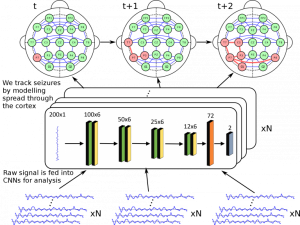 Epilepsy affects nearly 3.5 million people in the United States and is linked to a five-fold increase in mortality. While epilepsy is often controlled with medication, 20-40% of patients are medically refractory and continue to experience seizures in spite of drug therapies. The alternative for many of these patients is to surgically remove the areas of the brain responsible for triggering an epileptic seizure. However, the gold-standard procedure to localize the epileptic foci requires a craniotomy and implantation of electrode grids directly onto the cortical surface. This evaluation procedure is understandably traumatic and increases the patient risk for infection and injury.
Epilepsy affects nearly 3.5 million people in the United States and is linked to a five-fold increase in mortality. While epilepsy is often controlled with medication, 20-40% of patients are medically refractory and continue to experience seizures in spite of drug therapies. The alternative for many of these patients is to surgically remove the areas of the brain responsible for triggering an epileptic seizure. However, the gold-standard procedure to localize the epileptic foci requires a craniotomy and implantation of electrode grids directly onto the cortical surface. This evaluation procedure is understandably traumatic and increases the patient risk for infection and injury.
Hence, our goal is to automatically and noninvasively localize the seizure onset zones, which will both streamline the pre-surgical planning process and reduce the amount of time the patients spend in the hospital. As such, we have developed a novel Coupled Hidden Markov Model to detect and localize epileptic seizures in clinical EEG recordings. This model tracks the spatio-temporal propagation of a seizure to back-infer the onset. We have validated our approach on data from the Johns Hopkins Hospital and the Children’s Hospital in Boston. Ongoing work focuses on generalizing the performance via hierarchical graphical models and deep learning approaches. Moving forward, we will combine multiple snapshots of the brain, such as structural MRI, functional MRI and EEG in order to refine the localization.